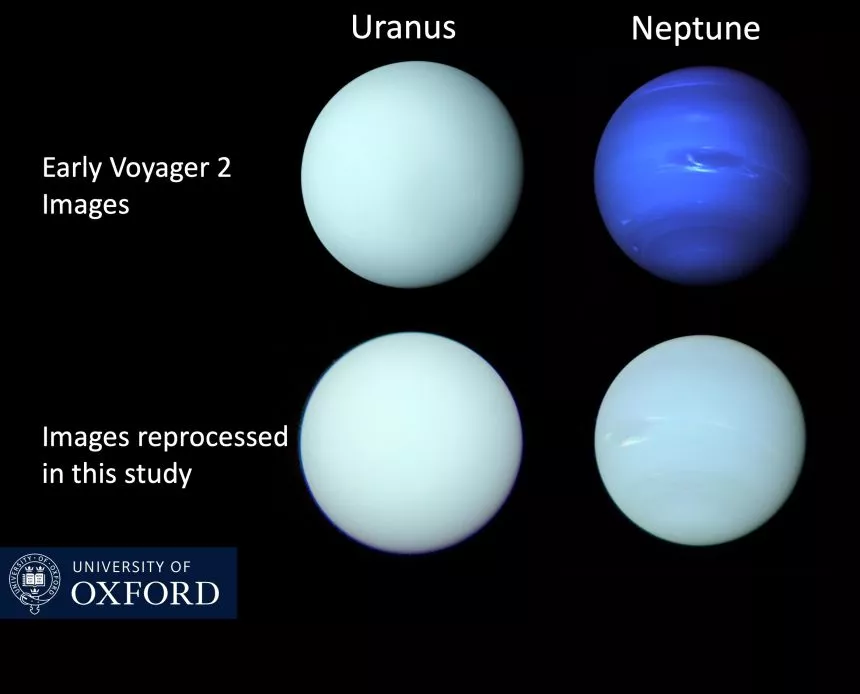A team of scientists from the University of Oxford has concluded that our popular ideas about the colors of the planets Uranus and Neptune are all wrong. Far from being two distinct shades, they are, in fact, nearly the same shade of greenish blue.
Ever since the first combination of telescope and camera, the public has been delighted by beautiful images of the universe. As technology has progressed, and humanity has moved out into space, these images have proliferated to the point where it's sometimes easy to take such grandeur for granted.
And yet, a lot of this beauty would vanish if we were only able to see it with the naked eye. The majority of the spectacular images of planets, stars, galaxies, and nebulae aren't much to look at through the eyepiece of a telescope. Jupiter and Saturn look like washed out discs. The Pleiades are just a collection of points of light, and galaxies and nebulae are colorless blobs of mist.
The reason so many images are so brilliant is they have been enhanced in various ways. The simplest is long exposure to draw in as much light as possible. This turns the Andromeda galaxy from a mist into a giant whirlpool of stars and the Crab Nebula from a blob into a many-filamented, colorful leftover of a supernova.
Another way is to use different wavelengths of light. Under visible light Venus looks like a dirty yellow ball of smog. Under infrared, the swirl of the clouds pops out. The same is true of images of Jupiter and Saturn collected by deep space probes and space telescopes. The naked eye reality may be dull, but by using different wavelengths, tweaking the contrast, and using false colors to bring out otherwise hidden features, the results can be amazing.

The mechanics of these enhanced images are well understood, but sometimes what something looks like in reality gets lost in the shuffle, as apparently happened in the case of Uranus and Neptune, which have popularly been regarded as the former having a washed out greenish blue appearance while the latter was a bright, deep blue. Scientists knew that these colors were a bit off, but they didn't realize how much.
A team led by Professor Patrick Irwin found out that this misconception came from the images sent back by Voyager 2, the only spacecraft to visit both planets. These weren't direct color images, but composite images where the planet was photographed using three filters – one for red, one for blue, and one for green. Each of these images was black and white, but when they were recombined using the appropriate optical filters they produced a full color image.
Unfortunately, these recombinations weren't balanced as well as they could be and their results tended to come out a bit on the blue side, which was especially the case with Neptune. This was further exaggerated when the contrast on the Neptune images was dialed up to reveal the clouds, bands and winds of the gas giant's atmosphere.
By using data from Hubble Space Telescope’s Space Telescope Imaging Spectrograph (STIS) and the Multi Unit Spectroscopic Explorer (MUSE) on the European Southern Observatory’s Very Large Telescope, the Oxford team had full-spectrum light images of Uranus and Neptune that they could use to build computer models for comparison with the Voyager 2 images. This allowed them to rebalance the composite color images and show that Uranus and Neptune are a similar shade of greenish blue, with Neptune coming off a tad more blue due to an extra layer of haze.
"Although the familiar Voyager 2 images of Uranus were published in a form closer to ‘true’ color, those of Neptune were, in fact, stretched and enhanced, and therefore made artificially too blue," said Irwin. “Even though the artificially-saturated color was known at the time among planetary scientists – and the images were released with captions explaining it – that distinction had become lost over time. Applying our model to the original data, we have been able to reconstitute the most accurate representation yet of the color of both Neptune and Uranus."
The results were published in the Monthly Notices of the Royal Astronomical Society.
Source: Royal Astronomical Society





